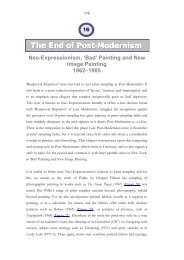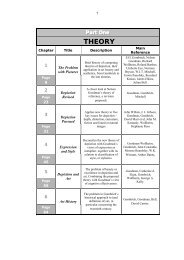- Page 2 and 3: 2 Depiction and Painting A Theory a
- Page 4 and 5: 4 Introduction The scope and method
- Page 6 and 7: 6 To note particulars of presentati
- Page 8 and 9: 8 7 Page 72 Interpretation The prob
- Page 10 and 11: 10 initially in Art and Illusion, a
- Page 12 and 13: 12 of any likeness or resemblance a
- Page 14 and 15: 14 assumes elements of one scheme o
- Page 16 and 17: 16 same time he rejects any simple
- Page 18 and 19: 18 arrangements of only straight li
- Page 20 and 21: 20 applied Goodman’s ideas of pic
- Page 22 and 23: 22 object ought to represent a pict
- Page 24 and 25: 24 place and manner of storage. Exe
- Page 26 and 27: 26 appreciation of two-dimensional
- Page 28 and 29: 28 Neither the primitive, pre-histo
- Page 30 and 31: 30 surface is altered or marked in
- Page 32 and 33: 32 may be detected and displayed ac
- Page 34 and 35: 34 only the crudest of ‘environme
- Page 38 and 39: 38 the light. But since the chemica
- Page 40 and 41: 40 its location within the categori
- Page 42 and 43: 42 exophthalmia, will suffice. But
- Page 44 and 45: 44 In explaining how a surface must
- Page 46 and 47: 46 range and or realm. 67 Irony for
- Page 48 and 49: 48 time or place. A source may be a
- Page 50 and 51: 50 on the perceived expressiveness
- Page 52 and 53: 52 of ways, and in fact must be fur
- Page 54 and 55: 54 Gombrich, his theory sells styli
- Page 56 and 57: 56 or with effective understanding,
- Page 58 and 59: 58 the same reason that one directi
- Page 60 and 61: 60 nineteenth century, revising in
- Page 62 and 63: 62 variety of modes. Science too ha
- Page 64 and 65: 64 Art History As noted, Gombrich
- Page 66 and 67: 66 will suffice to point to the sym
- Page 68 and 69: 68 wonders how much pressure can th
- Page 70 and 71: 70 quite reach nothing, anymore tha
- Page 72 and 73: 72 Interpretation Attention to hist
- Page 74 and 75: 74 mind, as Claude Levi-Strauss fam
- Page 76 and 77: 76 A short defence is that the obje
- Page 78 and 79: 78 Also, plural right interpretatio
- Page 80 and 81: 80 and ‘realistic’ of photograp
- Page 82 and 83: 82 tonal contrasts for a given part
- Page 84 and 85: 84 hold for all periods, and while
- Page 86 and 87:
86 precedents and versions. Whether
- Page 88 and 89:
88 To return to the example of Poll
- Page 90 and 91:
90 But versatility also arises thro
- Page 92 and 93:
92 may find it the strictest and so
- Page 94 and 95:
94 But the argument is really about
- Page 96 and 97:
96 establishes a premise from which
- Page 98 and 99:
98 painting fail unless committed t
- Page 100 and 101:
100 scarcely the only, much less be
- Page 102 and 103:
102 Goliath, or Titian’s The Flay
- Page 104 and 105:
104 Summary A review of the controv
- Page 106 and 107:
106 interpretations require a right
- Page 108 and 109:
108 and that revision of judgements
- Page 110 and 111:
110 15 Page 164 Post-Modernism Cont
- Page 112 and 113:
112 Modernism and Abstraction Discu
- Page 114 and 115:
114 patterns of emigration and so o
- Page 116 and 117:
116 in the sorts of objects and pic
- Page 118 and 119:
118 be shown, abstraction not only
- Page 120 and 121:
120 filling colours. Ordering is al
- Page 122 and 123:
122 words, steers abstraction, asse
- Page 124 and 125:
124 not exemplified only by the exc
- Page 126 and 127:
126 Modernism: 1912-1950 ‘Simulta
- Page 128 and 129:
128 pattern of the picture plane, t
- Page 130 and 131:
130 Photographs and other forms of
- Page 132 and 133:
132 also breasts, like faces and ha
- Page 134 and 135:
134 confront a daunting spatial and
- Page 136 and 137:
136 Yet two-dimensionality lurks be
- Page 138 and 139:
138 Late Modernism 1950 - 1960 ‘R
- Page 140 and 141:
140 between pictures and other elem
- Page 142 and 143:
142 reciprocally mapping grades aga
- Page 144 and 145:
144 Rauschenberg’s further contri
- Page 146 and 147:
146 essentially a short-tern strate
- Page 148 and 149:
148 The use of blank ground or unde
- Page 150 and 151:
150 Post-Modernism and Pop Art Pain
- Page 152 and 153:
152 painting now starkly defines it
- Page 154 and 155:
154 print source. Either way, contr
- Page 156 and 157:
156 as does the work of Frenchman B
- Page 158 and 159:
158 prominence. 234 The passivity o
- Page 160 and 161:
160 insight, and occasionally these
- Page 162 and 163:
162 with and without sequence, by t
- Page 164 and 165:
164 Post-Modernism Continued Painti
- Page 166 and 167:
166 the thirteen most wanted men fr
- Page 168 and 169:
168 Chapel beneath, serves as a pro
- Page 170 and 171:
170 paintings the blurring becomes
- Page 172 and 173:
172 more into them’ than the phot
- Page 174 and 175:
174 As shown, where sample eliminat
- Page 176 and 177:
176 The End of Post-Modernism Neo-E
- Page 178 and 179:
178 into a single, awkward hybrid o
- Page 180 and 181:
180 acquires a certain half-hearted
- Page 182 and 183:
182 an ironic revival, a pastiche o
- Page 184 and 185:
184 not treatment of these, than si
- Page 186 and 187:
186 (1913-80) the racial satires of
- Page 188 and 189:
188 ‘fill’ here engage only the
- Page 190 and 191:
190 thick paint, give the work a st
- Page 192 and 193:
192 single colour or tone in order
- Page 194 and 195:
194 of number and relations) is to
- Page 196 and 197:
196 hardly novel. 289 Indeed it is
- Page 198 and 199:
198 Looking to the materials of pig
- Page 200 and 201:
200 and facture. 298 More forthrigh
- Page 202 and 203:
202 Taaffe (b.1955) from this time
- Page 204 and 205:
204 ‘Expanded Materials’ In Lat
- Page 206 and 207:
206 Art in London around the middle
- Page 208 and 209:
208 of Gift For Apollo (1959). 310
- Page 210 and 211:
210 and performances on the one han
- Page 212 and 213:
212 situations, such as a sign indi
- Page 214 and 215:
214 But to begin with, the minimal
- Page 216 and 217:
216 Indeed as dance and drama explo
- Page 218 and 219:
218 increasing civic co-operation,
- Page 220 and 221:
220 are regularly documented, photo
- Page 222 and 223:
222 ‘layout’, for example in th
- Page 224 and 225:
224 and diminutions taken here as L
- Page 226 and 227:
226 somewhat the reverse. The work
- Page 228 and 229:
228 does not rest with mere casting
- Page 230 and 231:
230 This convergence of projects al
- Page 232 and 233:
232 is not enough to simply repeat
- Page 234 and 235:
234 perhaps a Mondrian) to the curv
- Page 236 and 237:
236 Therese Oulton (b. 1953) at thi
- Page 238 and 239:
238 The use of stereotypical silhou
- Page 240 and 241:
240 a broader ‘badness’ by this
- Page 242 and 243:
242 Similar approaches are later ad
- Page 244 and 245:
244 writing presents peculiar diffi
- Page 246 and 247:
246 Landscape here is traced back t
- Page 248 and 249:
248 or aggressive to traditions or
- Page 250 and 251:
250 needed or enough for a period;
- Page 252 and 253:
252 differences to picture plane sc
- Page 254 and 255:
254 Interestingly, labels for compe
- Page 256 and 257:
256 curatorial practice and collect
- Page 258 and 259:
258 the brittle bodily disproportio
- Page 260 and 261:
260 AMMAN, Jean-Christophe. ‘Der
- Page 262 and 263:
262 BAXANDALL, Michael. Patterns Of
- Page 264 and 265:
264 Pop Art: U.S./U.K. Connections,
- Page 266 and 267:
266 CAWS, Mary Ann. The Eye in the
- Page 268 and 269:
268 DAMISCH, Hubert, 'Five Notes fo
- Page 270 and 271:
270 Art and the Aesthetic, Cornell
- Page 272 and 273:
272 Why Are Pictures Puzzles? On Th
- Page 274 and 275:
274 FREDERIC, Paul and SEWARD, Keit
- Page 276 and 277:
276 ‘Selected Works by Jay De Feo
- Page 278 and 279:
278 ------------------------- Probl
- Page 280 and 281:
280 GRIFFITHS, Paul. Cage, The Oxfo
- Page 282 and 283:
282 HOCKNEY, David. Pictures (selec
- Page 284 and 285:
284 Shark infested waters: the Saat
- Page 286 and 287:
286 LANE, Michael. Structuralism: A
- Page 288 and 289:
288 LOVELACE, Carey. ‘Lisa Yuskav
- Page 290 and 291:
290 Art and the Public Sphere, Univ
- Page 292 and 293:
292 OLIVER, Cordelia, ‘The Second
- Page 294 and 295:
294 Chuck Close, (catalogue) Hatje
- Page 296 and 297:
296 Frank Stella, Penguin Books, Lo
- Page 298 and 299:
298 --------------------------- Sal
- Page 300 and 301:
300 -------------------------- Pict
- Page 302 and 303:
302 TOMKINS, Calvin. The Bride and
- Page 304 and 305:
304 WILSON, B. and WILSON, M. ‘An




